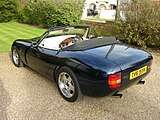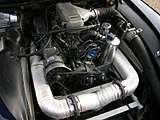TVR Griffith
The TVR Griffith, later models being referred to as the Griffith 500, is a sports car designed and built by TVR starting production in 1991 and ending production in 2002. The Griffith name appeared again on a sports car introduced under a revived TVR brand in 2017.
| TVR Griffith | |
|---|---|
 TVR Griffith (first generation) | |
| Overview | |
| Manufacturer | TVR Motor Company Limited TVR Automotive Limited |
| Production |
|
| Assembly | |
| Body and chassis | |
| Class | Sports car (S) |
| Layout |
|
First generation (1991–2002)
| First generation | |
|---|---|
.jpg) TVR Griffith 500 | |
| Overview | |
| Manufacturer | TVR Motor Company Limited |
| Production | 1991–2002 (2351 produced)[2] |
| Body and chassis | |
| Class | Sports car (S) |
| Body style | 2-door roadster |
| Platform | Fiberglass body over tubular steel chassis |
| Related | |
| Powertrain | |
| Engine | |
| Power output |
|
| Transmission | |
| Dimensions | |
| Wheelbase | 2,286 mm (90.0 in)[3] |
| Length | 3,891 mm (153.2 in)[3] |
| Width | 1,720 mm (67.7 in)[3] |
| Height | 1,204 mm (47.4 in)[3] |
| Kerb weight |
|
| Chronology | |
| Successor |
|
Like its forerunner namesakes, the Griffith 200 and Griffith 400, the modern Griffith was a lightweight (1,060 kg (2,337 lb)) fiberglass-bodied, 2-door, 2-seat sports car with a V8 engine. Originally, it used a 4.0 L 240 hp (179 kW; 243 PS) Rover V8 engine, but that could be optionally increased to 4.3 L 280 hp (209 kW; 284 PS) in 1992 with a further option of big-valve cylinder heads. In 1993, with a TVR-developed 5.0 L 340 hp (254 kW; 345 PS) version of the Rover V8 became available. All versions of the Griffith use the Lucas 14CUX engine management system. All models use a five-speed manual transmission.
Although the Griffith was almost mechanically identical to its sister car, the Chimaera, it had a different body design and was produced in much smaller numbers. [2]
The Griffith was a lightweight, high-power, and well-balanced car. A low-cost speed six Griffith proposal never became a production reality; by the time it was launched alongside the Griffith in 1999, it had morphed into the Tuscan Speed Six.
A special edition Griffith 500 was made dubbed the Blackpool B340. This car was featured in Gran Turismo, Gran Turismo 2 (in the former as the Griffith 4.0 in the NTSC and PAL versions) and Driving Emotion Type-S. The car was similar to a normal Griffith 500 with some bespoke options available.
In 2000, TVR announced that the Griffith production was going to end. A limited edition run of 100 Special Edition (SE) cars were to be built to mark the end of production. Although still very similar to the previous Griffith 500 model, the SE had a hybrid interior using the Chimaera dashboard and Cerbera seats. Noticeably, the rear lights were different along with different door mirrors, higher powered headlights and clear indicator lenses. Some also came with 16-inch wheels. Each car came with a numbered plaque in the glove box including the build number and a Special Edition Badge on its boot. All cars also had a unique signature in the boot under the carpet. The SEs were built between 2000 and 2002, with the last registered in 2003.
Every year, to celebrate the TVR Griffith, their owners have a meet called "The Griff Growl."[4]

In 2008, Al Melling Sports Cars unveiled the Melling Wildcat, a roadster heavily based on the Griffith but powered by a variant of TVR's later AJP8 engine.
Specifications
Engine
Name: Rover alloy V8
Valvetrain setup: 2 valves per cylinder, Overhead Valve
| Model | Displacement | Power | Torque | Max speed | 0–97 km/h (0–60 mph) (seconds) | 0–161 km/h (0–100 mph) (seconds) |
|---|---|---|---|---|---|---|
| 4.0 | 3,950 | 240 hp (179 kW; 243 PS) | 270 lb⋅ft (366 N⋅m) at 4000 rpm | 245 km/h (152 mph) | 4.7 | 12.1 |
| 4.0 HC | 3,950 Hi-Lift Cam | 275 hp (205 kW; 279 PS) | 305 lb⋅ft (414 N⋅m) | 254 km/h (158 mph) | 4.7 | 12.1 |
| 4.3 | 4,280 | 280 hp (209 kW; 284 PS) | 305 lb⋅ft (414 N⋅m) at 4000 rpm | 254 km/h (158 mph) | 4.6 | 11.3 |
| 4.5 | 4,495 | 285 hp (213 kW; 289 PS) | 310 lb⋅ft (420 N⋅m) | 254 km/h (158 mph) | 4.6 | |
| 5.0 | 4,988 | 340 hp (254 kW; 345 PS) | 350 lb⋅ft (475 N⋅m) (320 lb⋅ft (434 N⋅m) with catalyzer) | 272 km/h (169 mph) | 4.1 | 10.5 |
Transmission
Transmission: 5-speed manual (Rover LT77 or Tremec T5)
Suspension
Front: Independent, double wishbones, coil-over gas dampers, sway bars
Rear: Independent, double wishbones, coil-over gas dampers, sway bars
Brakes
Front: 260 mm (10.2 in) ventilated disc brakes
Rear: 260 mm (10.2 in) ventilated disc brakes
Wheels Front: 15 in aluminium alloy
Chassis/body
Body Panels: Glass fibre
Fuel Capacity: 57 Litres (12.5 Imp. gallons, 15.0 U.S. gal)
Weight: 1,060 kg (2,336 lb) (dry)
Length: 3,891 mm (153.2 in)
Height: 1,204 mm (47.4 in)
Width: 1,720 mm (67.7 in)
Wheelbase: 2,286 mm (90.0 in)
Front track: 1,461 mm (57.5 in)
Rear track: 1,471 mm (57.9 in)
Ground clearance: 145 mm (5.7 in)
 Rear third quarter view
Rear third quarter view- Interior
 4.0 L V8 engine
4.0 L V8 engine
Second generation (2020–)
| Second generation | |
|---|---|
_(38354185236).jpg) TVR Griffith at NEC Classic Car Show in Birmingham 2017 | |
| Overview | |
| Manufacturer | TVR Automotive Limited |
| Production | 2020 (expected) |
| Designer | Gordon Murray |
| Body and chassis | |
| Body style | 2-door coupé |
| Layout | Longitudinal-mounted, front mid-engine, rear-wheel drive |
| Powertrain | |
| Engine | 5.0 L Cosworth Ford Coyote V8 |
| Power output | 500 PS (368 kW; 493 hp) |
| Transmission | 6-speed manual |
| Dimensions | |
| Wheelbase | 2,601 mm (102.4 in)[5] |
| Length | 4,313 mm (169.8 in)[5] |
| Width | 1,849 mm (72.8 in)[5] |
| Height | 1,240 mm (48.8 in)[5] |
| Kerb weight | 1,250 kg (2,756 lb) (dry)[5] |
| Chronology | |
| Predecessor |
|
_(38354184736).jpg)
On 8 September 2017, to coincide with the marque's 70th anniversary year[6] at the Goodwood Revival, a new Griffith was revealed under the now resurrected TVR marque, featuring design work by Gordon Murray. It features a Cosworth modified Ford Coyote 5.0-litre V8 engine[lower-alpha 1] producing 500 bhp (507 PS; 373 kW), double wishbone suspension with adjustable coilover dampers, a carbon fibre ground effect chassis.[7]. It can accelerate from 0 to 60 mph (97 km/h) in approximately 4 seconds and can achieve a top speed in excess of 322 km/h (200 mph). The new Griffith retains the manual transmission as used in the previous TVR models making it a proper driver's car but includes ABS, power steering and traction control as standard in order to handle the high power output and keep the car stable at high speeds. The extensive use of carbon fibre helps save weight and as a result, it weighs less than 1,250 kg (2,756 lb) with a 50:50 weight distribution achieved through the Griffith's architecture of aluminum and carbon fibre components which improves handling. Design elements such as large front air intakes, front splitter and rear integrated diffuser help in increasing aero dynamics while the double side exhausts and a double bubble roof add to the car's purposeful look. Inside the car, a driver-focused setup is kept in mind with a digital instrument cluster providing useful information and minimum controls present on the steering wheel and dashboard. Air conditioning, leather interior trim and multimedia system come as standard as well. The Griffith was expected to start production in 2019 with an initial run of 500 Launch Edition (LE) cars and a price tag of ₤89,995. [8] The launch date is now early to mid-2020 due to European Union regulations. As the Welsh government owns 3% of TVR, it is required to solicit bids for the factory renovations across all the EU, which has delayed commencement of production.[9]
Production by year
- 1992: 602
- 1993: 230 (169 2DR + 61 500)
- 1994: 292
- 1995: 284
- 1996: 288
- 1997: 232
- 1998: 231
- 1999: 187
- 2000: 90
- 2001: 82
- 2002: 64
- 2020: To be started
Notes
- this engine used in Falcon FGX XR8 (With additional Harrop/Eaton Supercharger) and Mustang GT (without Supercharger)
References
- "TVR Griffith begins production again". Retrieved 8 September 2017.
- "TVR official production numbers". Retrieved 3 February 2018.
- "1991–2002 TVR Griffith specifications". Auto Evolution. Retrieved 2 February 2018.
- Griff Growl
- "TVR Griffith 2018 specifications". Auto Evolution. Retrieved 2 February 2018.
- "Long-awaited new TVR to be launched at Revival 2017". GRRC. Retrieved 19 June 2017.
- "New TVR Launch at Goodwood Revival 2017". Retrieved 8 September 2017.
- "TVR Griffith". TVR. Retrieved 4 September 2018.
- "TVR Griffith Delayed Until 2020 Due To EU Regulations". carscoops.com.
- http://www.pistonheads.com/gassing/topic.asp?h=0&f=9&t=647743&mid=0&i=0&nmt=How+many+tvr+griffiths+were+made+%3F&mid=0
- http://www.pistonheads.com/gassing/topic.asp?h=0&f=9&t=647743&mid=0&i=20&nmt=How+many+tvr+griffiths+were+made+%3F&mid=0
External links
| Wikimedia Commons has media related to TVR Griffith. |
- TVR Griffith at PistonHeads.com
- TVR Griffith Info and Owners Register
- TVR Griffith 500 SE Register
- TVR Car Club
- Griffith MotorCar Club International